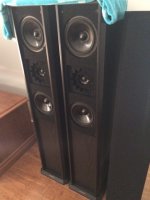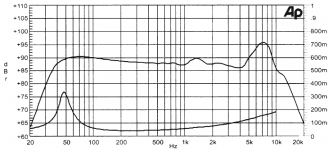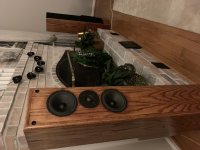P13
Circa 1995, small value of series resistance to the paralleled P13's, 5uF to the phase reversed Seas T25CF-001. Three seperate and sealed compartments. They dont go that low, but they're happy with 7 watts and blend well enough with a decent subwoofer.
Circa 1995, small value of series resistance to the paralleled P13's, 5uF to the phase reversed Seas T25CF-001. Three seperate and sealed compartments. They dont go that low, but they're happy with 7 watts and blend well enough with a decent subwoofer.
Attachments
Last edited:
I'd think with a small driver in a small box, you must go reflex for any sort of bass. Just one of my notions, based on some resonance coupling theory, but series wired basses are the best solution in a common enclosure, which is easier to build.
Low order filters are OK, but again for headroom without distortion, we must compromise to higher order stuff.
I must be hatching my next cunning project here... 😱

Something tells me I should try one of Dave's Fostex fullrange FE or FF85 units as a tweeter that can dig low!
Buy Fostex Full Range Drive Units and Co-Axial Units Online, UK
M'learned friend, sreten had this to say:
MTM has far more WAF than most stuff. We do, after all, have to live with these big lumps. Er, the speakers that is. 😀
Low order filters are OK, but again for headroom without distortion, we must compromise to higher order stuff.
I must be hatching my next cunning project here... 😱

Something tells me I should try one of Dave's Fostex fullrange FE or FF85 units as a tweeter that can dig low!
Buy Fostex Full Range Drive Units and Co-Axial Units Online, UK
M'learned friend, sreten had this to say:
Hi,
Proper two way 8" bass mid drivers are out of fashion,
most 8" units are strictly 3 way bass units nowadays.
Reason ? MTM 2-ways and MMT 2.5 ways.
Look at : Zaph|Audio
rgds, sreten.
MTM has far more WAF than most stuff. We do, after all, have to live with these big lumps. Er, the speakers that is. 😀
Last edited:
re:'series wired basses are the best solution in a common enclosure" - an intriguing pearl there Sys7, care to elaborate? cheers
It seems his mind was aglow with transient nodes of thought, on that day, but what does this really tell us? It's like one of those half baked thoughts we may find scrawled on the back of an envelope and throw away because on its own it makes no sense.This is a thought experiment by Steen Duelund about the box and the room:
From my experience series wired drivers in vented enclosures don't work properly. Some years ago i had to build a pair of subs that had two peerless 12" CC line woofers (8 ohms) in each box, and I wired both drivers in series (16 ohms) for both boxes, then connected both boxes in parallel (back to 8 ohms) and tested them... they didnt sound "right", so i did a frequency sweep...WTF.. usually you expect all the drivers to have a minimum cone excursion at vent tuning, but one of the drivers in one box was moving a lot more than the other three (and even then there were slight differences in the excursions of those) and that driver had its minimum excursion at a lower frequency.
I didnt have the time or the gear to test impedance (was at customers premises) so i connected them up in parallel pairs and wired them in series and that fixed the problem.
I did a bit of research after this to find out what caused this and from what i remember, is that any large differences in the specs of the drivers can cause this to happen when series connected, so unless you have too I wouldn't recommend it.
cheers, Arthur.
I didnt have the time or the gear to test impedance (was at customers premises) so i connected them up in parallel pairs and wired them in series and that fixed the problem.
I did a bit of research after this to find out what caused this and from what i remember, is that any large differences in the specs of the drivers can cause this to happen when series connected, so unless you have too I wouldn't recommend it.
cheers, Arthur.
Do you remember being at Cricket practice as a wicketkeeper, and three fielders threw a ball back to you at the same time? I do... 😀
First incoming ball from PeterMcK:
Oh goodness, you are pushing me down a road that can cause great controversy. 😱
What I can tell you is Lynn Olson built separate enclosures for his parallel wired P13WH basses in the big transmission line Ariel.
What happens at a simplistic level with two basses in a common enclosure? Push one in, the other pops out. Agreed? A simple question of air pressure... 😎
There are electrical questions to do with damping that might reduce or increase the effect.
Where I got to with a thought experiment was that series wired might ensure the midbasses actually work together in a common enclosure:
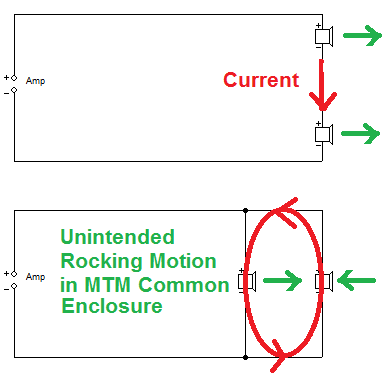
I could be wrong on this, but have seen nothing to contradict the notion. Seems to me that no matter how good the control from the amp is, it can do nothing to stop the rocking motion on the parallel basses in a common enclosure. As long as the basses are mechanically identical, everything ought to be symmetric, but is that the real World?
Second incoming ball from AllenB:
And Allen, I am doubtless distracted by the Rugby today. England versus RSA it is, next week. I think we have more than enough for RSA with our 100mph style, but certainly more interesting than playing local rivals Wales again. 😎
The room, by Steen Duelund:
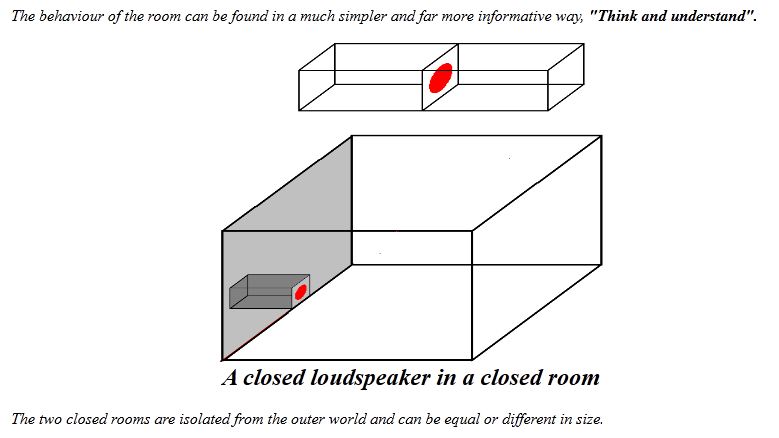
I don't mind a thought experiment at all. Steen doesn't explicitly mention reflections from nearby boundaries, he doesn't take the box into the room which might need bafflestep to work. He doesn't go into the difference between a wooden Scandinavian house and a stone-walled or brick-walled British one.
But I got it.
FWIW, a good physicist once explained the Dirac Positron on the back of a beermat to me. Just an alternative negative 4-dimensional matrix solution to the Electron. A masterpiece of conciseness, IMO. Course, I couldn't do it myself.
Third incoming ball from afa:
Can't explain that one. Terrible paragraphing and layout though. Almost unreadable. 😱
But it is strange how with reflex and auxiliary bass radiators, one driver is almost stationary while the other one or port goes crazy on amplitude.
First incoming ball from PeterMcK:
re:'series wired basses are the best solution in a common enclosure" - an intriguing pearl there Sys7, care to elaborate? cheers
Oh goodness, you are pushing me down a road that can cause great controversy. 😱
What I can tell you is Lynn Olson built separate enclosures for his parallel wired P13WH basses in the big transmission line Ariel.
What happens at a simplistic level with two basses in a common enclosure? Push one in, the other pops out. Agreed? A simple question of air pressure... 😎
There are electrical questions to do with damping that might reduce or increase the effect.
Where I got to with a thought experiment was that series wired might ensure the midbasses actually work together in a common enclosure:
I could be wrong on this, but have seen nothing to contradict the notion. Seems to me that no matter how good the control from the amp is, it can do nothing to stop the rocking motion on the parallel basses in a common enclosure. As long as the basses are mechanically identical, everything ought to be symmetric, but is that the real World?
Second incoming ball from AllenB:
And Allen, I am doubtless distracted by the Rugby today. England versus RSA it is, next week. I think we have more than enough for RSA with our 100mph style, but certainly more interesting than playing local rivals Wales again. 😎
The room, by Steen Duelund:
I don't mind a thought experiment at all. Steen doesn't explicitly mention reflections from nearby boundaries, he doesn't take the box into the room which might need bafflestep to work. He doesn't go into the difference between a wooden Scandinavian house and a stone-walled or brick-walled British one.
But I got it.
FWIW, a good physicist once explained the Dirac Positron on the back of a beermat to me. Just an alternative negative 4-dimensional matrix solution to the Electron. A masterpiece of conciseness, IMO. Course, I couldn't do it myself.
Third incoming ball from afa:
From my experience series wired drivers in vented enclosures don't work properly. Some years ago i had to build a pair of subs that had two peerless 12" CC line woofers (8 ohms) in each box, and I wired both drivers in series (16 ohms) for both boxes, then connected both boxes in parallel (back to 8 ohms) and tested them... they didnt sound "right", so i did a frequency sweep...WTF.. usually you expect all the drivers to have a minimum cone excursion at vent tuning, but one of the drivers in one box was moving a lot more than the other three (and even then there were slight differences in the excursions of those) and that driver had its minimum excursion at a lower frequency.
I didnt have the time or the gear to test impedance (was at customers premises) so i connected them up in parallel pairs and wired them in series and that fixed the problem.
I did a bit of research after this to find out what caused this and from what i remember, is that any large differences in the specs of the drivers can cause this to happen when series connected, so unless you have too I wouldn't recommend it.
cheers, Arthur.
Can't explain that one. Terrible paragraphing and layout though. Almost unreadable. 😱
But it is strange how with reflex and auxiliary bass radiators, one driver is almost stationary while the other one or port goes crazy on amplitude.
Last edited:
From my experience series wired drivers in vented enclosures don't work properly.
Some years ago i had to build a pair of subs that had two peerless 12" CC line woofers (8 ohms) in each box, and I wired both drivers in series (16 ohms) for both boxes, then connected both boxes in parallel (back to 8 ohms) and tested them... they didnt sound "right".
So I did a frequency sweep...WTF.. usually you expect all the drivers to have a minimum cone excursion at vent tuning, but one of the drivers in one box was moving a lot more than the other three (and even then there were slight differences in the excursions of those) and that driver had its minimum excursion at a lower frequency.
I didnt have the time or the gear to test impedance (was at customers premises) so i connected them up in parallel pairs and wired them in series and that fixed the problem.
I did a bit of research after this to find out what caused this and from what i remember, is that any large differences in the specs of the drivers can cause this to happen when series connected, so unless you have too I wouldn't recommend it.
cheers, Arthur.
Mulling that experience over, I wonder if one of the woofers in the twin cab, series wired, was initially wired negative polarity, aka "Out of Phase"? Now that would definitely sound "wrong" especially with twin woofers.
By rewiring in parallel you may have corrected the worst of the problem. Doesn't explain everything, but it is very common to get polarity wrong.
Something tells me I should try one of Dave's Fostex fullrange FE or FF85 units as a tweeter that can dig low!
FF85wk. Do note that out of the box, the Mark Audio Alpair 5.2/3 is a better driver. Once i fix some of the Fostexes issues and EnABL both they start getting real close. The Fostex has about a 5 year lead on the MA, so that is why you have seen us use it dso often. It is a good driver, tarted up it is very good. In the right box these drivers can go to something like 65 Hz, but in the midTL used probably a 1/2 octave above that. XO 250-400 Hz or so. In the small box the W14s get below 50 Hz. In the Woden TL in Tysen V2 they get into the 30s.
Here one of my favorite FF85wKeN boxes — a set of µFonkenSET built by Bernie for CHris in solid walnut (there is a dedicated helper woofer for these that acts as a stand and turns the small standmount into a small, tallish, floor-stander with no apologies.:
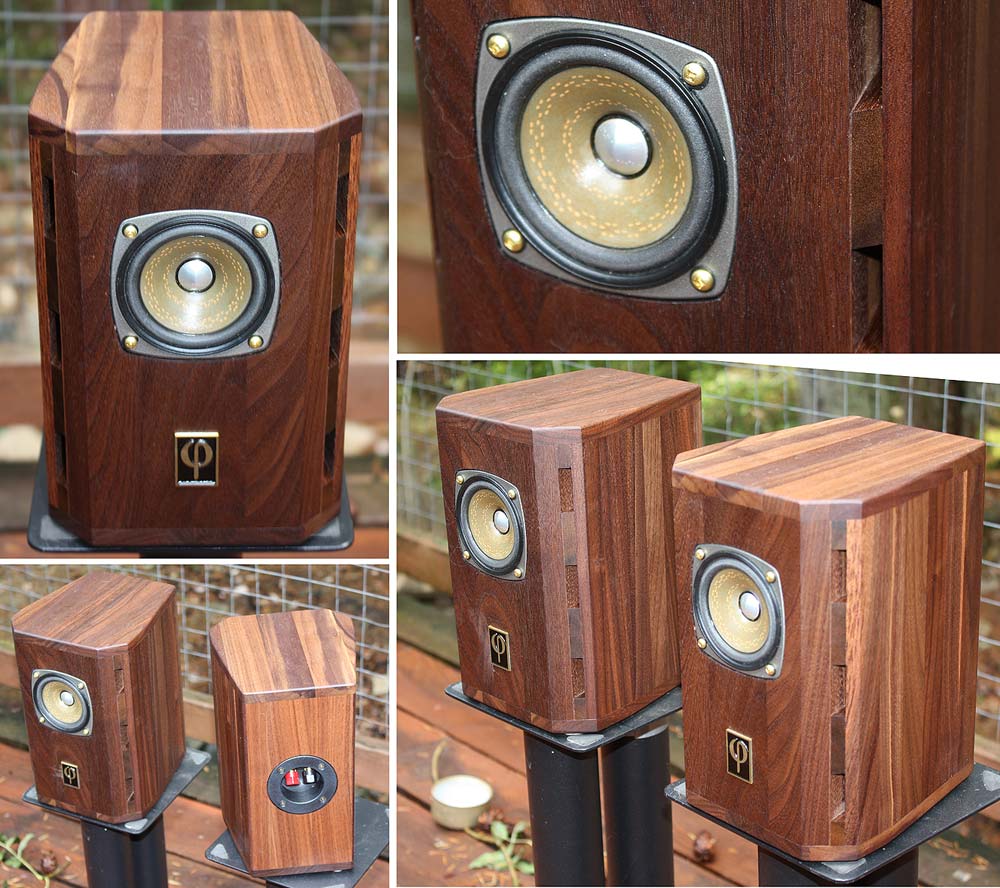
Listening in the big room, with the big hifi, both the standmount MTM pictured and the floorstander Tysen V2 with the same drivers, biamped, they play reasonably loud with good dynamics. Once the bass is relieved the FR can soar.
dave
I will wire bass drivers in Parallel or series depending on the context, impedance of the woofer, goal for sensitivity (if using a passive XO), and the amp driving the woofers.
in the MTM pictured and in Tysen V2 the 2 4Ω W14 are wired in series.
dave
in the MTM pictured and in Tysen V2 the 2 4Ω W14 are wired in series.
dave
Thanks for the explanation Steve, though TBH I'm thinking re:"Push one in, the other pops out" - sure, but usually it's the amp that's pushing both in the same direction, series or parallel...(maybe those old fashioned valve thingys do something different, with their higher output impedance).
Thanks for the explanation Steve, though TBH I'm thinking re:"Push one in, the other pops out" - sure, but usually it's the amp that's pushing both in the same direction, series or parallel...(maybe those old fashioned valve thingys do something different, with their higher output impedance).
Like I said, I could be wrong on this:
But that is my current thinking.
Reason I focus on series wired these days, is the conversion of an MT to a series wired MTM is particularly easy.
Vifa PL14WJ-
Double coil and resistor values, halve capacitors in the MT bass circuit, and the tweeter filter is unaffected. Oh, and double volume and ports. 😎
I'm not sure I want to take on a paper 5" though. Maybe a Peerless 830860 polycone is a better way to do things, and like the P13WH in this thread:
Peerless HDS PPB 830860
planet10, aka Dave, has got me wondering if a FE83 or FF85 cone tweeter is also a good thing. I like them well enough myself for sheer musicality. Dome tweeters just lack something, IMO.

Buy Fostex Full Range Drive Units and Co-Axial Units Online, UK
Mark Audio is not so freely available in the UK, but Fostex is. I'd only have to make some simple enclosure behind a fullranger Fostex, and it works extremely well according to Dave. Like I said, I seem to be hatching an idea here. 🙂
re:'take on a paper 5"' - SB13PFC is surprisingly good, ATM trying them in both TMM & push-push cabs to see if there's a difference...
Some other "modern" drivers
Cheap Faital Pro 5FE120 FaitalPRO 5FE120 5" Professional Midbass Midrange Woofer 8 Ohm this driver is very cheap in Europe where you can find it for 20£. According to the manufacturer it has a smooth response.
Aurum Cantus 130 F1 Aurum Cantus AC-130F1 5-1/4" Woofer this is used in Jeff Bagby's Continuum. It also has a smooth response.
Cheap Faital Pro 5FE120 FaitalPRO 5FE120 5" Professional Midbass Midrange Woofer 8 Ohm this driver is very cheap in Europe where you can find it for 20£. According to the manufacturer it has a smooth response.
Aurum Cantus 130 F1 Aurum Cantus AC-130F1 5-1/4" Woofer this is used in Jeff Bagby's Continuum. It also has a smooth response.
Reason I focus on series wired these days, is the conversion of an MT to a series wired MTM is particularly easy.
Indeed, i plan on exactly that on 1st pass as i expand our Alpair 12pw/A7 MTM to use 4 woofers instead of 2. From 2 wired in parallel at 4Ω nominal to series/parallel at 8Ω nominal.
One can also to some times take advantage of series wired midbasses to roll off one with a shunt cap. HF XO C-C decreases, excursion at lower frequencies is one-forth, with little to no change in sensitivity.
I'm not sure I want to take on a paper 5"
Silver Flute W14 has an exotic wool-paper cone and i add a thin surface layer of PVA and then acylic to them. Haven’t yet used them above 450 Hz yet, but have a lot of them, and a zillion surplus domes (a set of Fostex inverted domes might be interesting). Stock it is not well behaved up top, but the midbasses i have treated, that have a badly behaving top end behaviour, and been measured, have shown a marked reduction in the issues they have so who knows.
a FE83 or FF85 cone tweeter is also a good thing
We prefer the treated FF85, when we 1st treated an earlier version of the FF85 we at 1st really wondered how it could be sold for as much as they would need to be once treated, but then we heard them and realized that they rivaled some equally valued domes and could go down to 90 Hz. FE83 is hardly capable of any bass, and has a very pleasant but somewhat euphoric midTop. After that all my domes became surplus.
Mark Audio is not so freely available in the UK
Certainly not for free, but can be had from Stefan at KJF Audio in Kent.
These what you want: Alpair 5 full range driver | KJF Audio
A cheaper stamped basket variation (i almost have mine in boxes): CHN-50 full range driver | KJF Audio
dave
Attachments
This thread is moving fast, I must do some catchup. LOL. Thanks, folks.
I do know the 5” SB13PFCR25-04 through Ryan of Impulse Audio:
YouTube
Does Ryan hang around here at diyaudio?
No really nasty breakups, and amazingly loud if 90dB is to be believed. But breakup there is, starting at 4kHz. That's very poor for a 5" unit IMO.
I must be getting old, but I hate breakup and listener fatigue. My ears howl when sound gets overly loud or harsh. I usually sit in the back row of the cinema, with all that Dolby stuff! 😱
TBH, I think Harbeth make the best 5" driver in the World, the polycone Radial II:
YouTube
A slightly rambling Alan Shaw explains listener fatigue. I think apart from a poor and distracting choice of shirt for television, he was finding it hard to stay cool and focussed with such a lovely interviewer...
YouTube
Hey, what do I know? 😀
I do know the 5” SB13PFCR25-04 through Ryan of Impulse Audio:
YouTube
Does Ryan hang around here at diyaudio?
No really nasty breakups, and amazingly loud if 90dB is to be believed. But breakup there is, starting at 4kHz. That's very poor for a 5" unit IMO.
I must be getting old, but I hate breakup and listener fatigue. My ears howl when sound gets overly loud or harsh. I usually sit in the back row of the cinema, with all that Dolby stuff! 😱
TBH, I think Harbeth make the best 5" driver in the World, the polycone Radial II:
YouTube
A slightly rambling Alan Shaw explains listener fatigue. I think apart from a poor and distracting choice of shirt for television, he was finding it hard to stay cool and focussed with such a lovely interviewer...
YouTube
Hey, what do I know? 😀
Last edited:
...
After reading many posts on this forum I made up my mind about transmission lines. Since this is going to be part of a surround system, there is going to be a subwoofer. I was thinking that since there's a subwoofer then there is no need for a 3 way. A 2-way should suffice I think. The speakers only need to be going down to 80Hz.
...
I know you said you want to build a TL, but I’ll tell you from experience, with a sub you don’t need to make something as complicated as the Ariel. In fact, it’s counter productive for a surround sound system.
The point of the Ariel was to get great efficiency and midrange performance by controlling dispersion and refraction, while still having “decent” bass response.
With a sub you’ve taken care of the low end. The rippley roll of the bass from a TL makes integration with the sub difficult. You end up crossing at 80-100 Hz anyway, so save the headache of the TL enclosure. I would just go with a sealed version of the Me2 instead.
To your OP, the P13 drivers aren’t available but they have sort of been continued with other poly-cones with similar characteristics. From Peerless by Tymphany you have the 830860 5.25”. Personally, I would go bigger with the with the ScanSpeak Classic P17WJ00 6.5" for the extra bass extension and slightly greater SPL, which should eliminate the need for the series resister on the tweeter.
Cheers and good luck on your project! I built mine in 1998! I did a much simpler 1/4-wl TL within the enclosure, but have long since plugged it and high pass them at 80Hz for better integration with stereo subs. The Ariels sound great and have decent bass extension in a medium size room, BUT they don’t go low enough (need a sub) and lack dynamic range (totally run out of gas at higher SPLs!).
Attachments
Setting room response aside, as a minor point, QW / TL variations should not have excessive nulls in their response. If they do, they haven't been designed properly. The Ariel is smooth enough.
Yep, in complete agreement, especially about proper design (and implementation).
Setting room response aside, as a minor point, QW / TL variations should not have excessive nulls in their response. If they do, they haven't been designed properly.
Way back when I was at Audionics and dinosaurs swam in the Willamette River, I got curious and T/S measured all our incoming production drivers. I wanted to know where the production variations came from, aside from the obvious duds (which were about 3%).
The three main things to measure are compliance, moving mass, and BL product ... they pretty much set the T/S parameters, assuming the driver is operating in the linear-excursion region. Moving mass, perhaps not surprisingly, is very consistent ... the only thing that varies significantly is a tiny amount due to some drivers having a little more glue then others, but that's only a fraction of gram.
BL is interesting. The "L" is very consistent, since it's nothing more than turns on a voice coil, and that's done with a machine that counts turns. But "B", regrettably, can vary by a dB or two, since it's not possible to charge magnets consistently. The variation in "B", in fact, is responsible for most of the efficiency variations in production drivers, and requires the drivers to be pre-sorted in production so you don't get a mismatch between L/R pairs. It also throws off crossover design, since tweeters vary along with bass drivers ... so the crossover will probably need a tapped resistor, or one selected in production after testing.
The other thing that varies is compliance. This is even worse, since it is mostly controlled by the spider, not the surround, and the spiders are very difficult to make consistently. First, they arrive from the manufacturer much stiffer than they will be after the customer has used them for a while, so they have to be "burned in" for some hours, and even then it takes them a while to settle down. And they up settling down to different values. Not good.
Now, in a closed box, this doesn't much matter, since compliance is mostly determined by box volume, not the stiffness of the spider, so the finished speakers end up measuring pretty similarly. In a vented box, the alignment slides along a continuum, not far from the ideal set of book values, so that's fairly acceptable as well. Some ripples might appear if the compliance is way off (like 30% high), but that's why all new drivers are tested before and after burn-in (and some are rejected and sent back).
This is where wiring drivers in series can really bite you. If the drivers were perfectly matched (hah!), no problem. But in the world where we live in, they are all over the place, especially the compliance factor, which might never settle down to a final value, depending on humidity, abuse, etc. etc. By contrast, the mass is going to stay the same until complete destruction, and BL is only going to change if the magnet gets weaker over time (which doesn't really happen with ceramic magnets).
You can see the obvious problem if they are wired in series, especially if the enclosure has a common volume. The Fs will NOT match, so you get two impedance peaks, not one. This isn't good, since the drivers are now transferring energy between each other, at least in the Fs region. Worse, the Fs of each driver is not a stable value, since compliance shifts with drive level ... it's not even very linear, unless you go to exotic double spiders with one reversed, or the really old-school "spider" assemblies made of copper or whatever.
This is why it's a good idea to step away from idealized models and take a good look at the real-world driver, and not just one, but a whole bunch of them in a production lot. It's important to know where the source of variation is coming from, and what can be done to alleviate it, or at least make the production loudspeaker not as sensitive to it. The design should never depend on idealized drivers.
The three main things to measure are compliance, moving mass, and BL product ... they pretty much set the T/S parameters, assuming the driver is operating in the linear-excursion region. Moving mass, perhaps not surprisingly, is very consistent ... the only thing that varies significantly is a tiny amount due to some drivers having a little more glue then others, but that's only a fraction of gram.
BL is interesting. The "L" is very consistent, since it's nothing more than turns on a voice coil, and that's done with a machine that counts turns. But "B", regrettably, can vary by a dB or two, since it's not possible to charge magnets consistently. The variation in "B", in fact, is responsible for most of the efficiency variations in production drivers, and requires the drivers to be pre-sorted in production so you don't get a mismatch between L/R pairs. It also throws off crossover design, since tweeters vary along with bass drivers ... so the crossover will probably need a tapped resistor, or one selected in production after testing.
The other thing that varies is compliance. This is even worse, since it is mostly controlled by the spider, not the surround, and the spiders are very difficult to make consistently. First, they arrive from the manufacturer much stiffer than they will be after the customer has used them for a while, so they have to be "burned in" for some hours, and even then it takes them a while to settle down. And they up settling down to different values. Not good.
Now, in a closed box, this doesn't much matter, since compliance is mostly determined by box volume, not the stiffness of the spider, so the finished speakers end up measuring pretty similarly. In a vented box, the alignment slides along a continuum, not far from the ideal set of book values, so that's fairly acceptable as well. Some ripples might appear if the compliance is way off (like 30% high), but that's why all new drivers are tested before and after burn-in (and some are rejected and sent back).
This is where wiring drivers in series can really bite you. If the drivers were perfectly matched (hah!), no problem. But in the world where we live in, they are all over the place, especially the compliance factor, which might never settle down to a final value, depending on humidity, abuse, etc. etc. By contrast, the mass is going to stay the same until complete destruction, and BL is only going to change if the magnet gets weaker over time (which doesn't really happen with ceramic magnets).
You can see the obvious problem if they are wired in series, especially if the enclosure has a common volume. The Fs will NOT match, so you get two impedance peaks, not one. This isn't good, since the drivers are now transferring energy between each other, at least in the Fs region. Worse, the Fs of each driver is not a stable value, since compliance shifts with drive level ... it's not even very linear, unless you go to exotic double spiders with one reversed, or the really old-school "spider" assemblies made of copper or whatever.
This is why it's a good idea to step away from idealized models and take a good look at the real-world driver, and not just one, but a whole bunch of them in a production lot. It's important to know where the source of variation is coming from, and what can be done to alleviate it, or at least make the production loudspeaker not as sensitive to it. The design should never depend on idealized drivers.
Last edited:
- Home
- Loudspeakers
- Multi-Way
- Drivers for Ariel speakers
